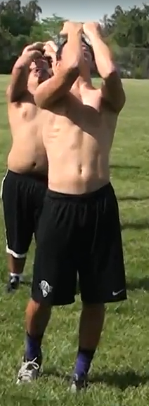Now, we will discuss the Strike Phase as well as Strike & Finish drills.
The Strike Phase begins as the defender starts to initiate contact with the ball carrier.
This phase incorporates an aggressive double uppercut action with the arms as well as rapid and forceful hip extension into the ball carrier.
We use five drills in the Strike Phase and start by teaching the rapid hip extension and then adding the double uppercut action. Finally, we will reteach the Hit Position (athletes who have been in our strength program are already well versed in this position) before we put the entire action together while standing.
I don't have video of all these drills against air, bags and partners, but you will just add someone in holding a bag for the Knee Strike and Strike drills. I think the Strike drill works best with a Pop-Up Bag that players can basically run through without having to add in the elements of the Finish Phase. The Superman and Superman Uppercut drills can be used without those bags on the ground, but the players are more likely to commit to selling out if they know they're landing on something comfy.
Some key points for these drills...
1. Superman: I did a bad job of this when I introduced it last year, but the athletes should have their hands behind their back so they can really concentrate of forcefully extending their hips.
2. Superman Uppercut: This is where we add the arms and the double uppercut action
3. Knee Strike: This is the same motion as Superman Uppercut, only now the players take a knee. I make them switch knees after every rep so we get even work on both sides.
4. Hit Position: Use a cadence to get athletes in the proper position. I lost the audio on the video here. We start with "Feet" and the athletes settle their feet hip distance apart. Next is "Arms" and the players stick their arms behind their back as far as possible. After that is "Sink" and the athletes sink into a half squat. The last cue is "Holsters" and the players will put their hands on their "gun holsters" by bending their elbows. Once we've mastered this by using a cadence, we will just tell the players "Hit" and they must quickly assume the Hit Position.
5. Strike: This is the drill that most closely resembles an actual tackle since we are standing and incorporating both the double uppercut and hip extension.
Once we progress through the Strike Phase, we will bring the Strike & Finish Phases together into one fluid (hopefully!) motion.
The goal is for the fundamentals of each phase to start transitioning into multiple phases as we add them together. As you can tell in some of the video, there are a fair amount of players who are missing some important concepts of the Finish Phase. There are a handful of athletes who aren't doing a good job squeezing their elbows together in the Clamp and many aren't putting their eyes to the sky as well.
Part IV will detail the Pursuit Phase, which consists of the Profile and Buzz tackles and include a document for our strict progression over the spring and summer.


